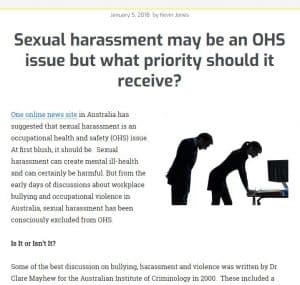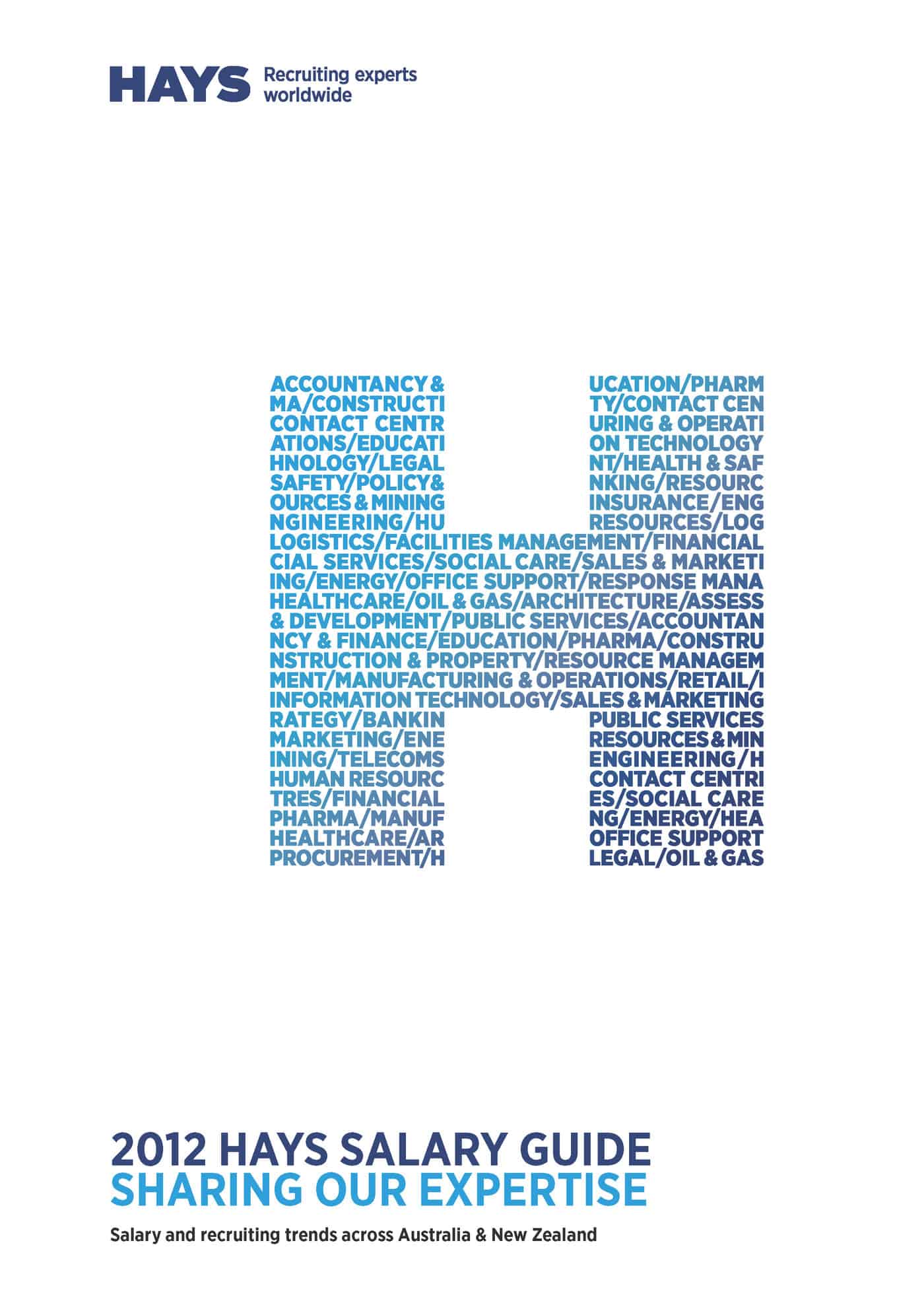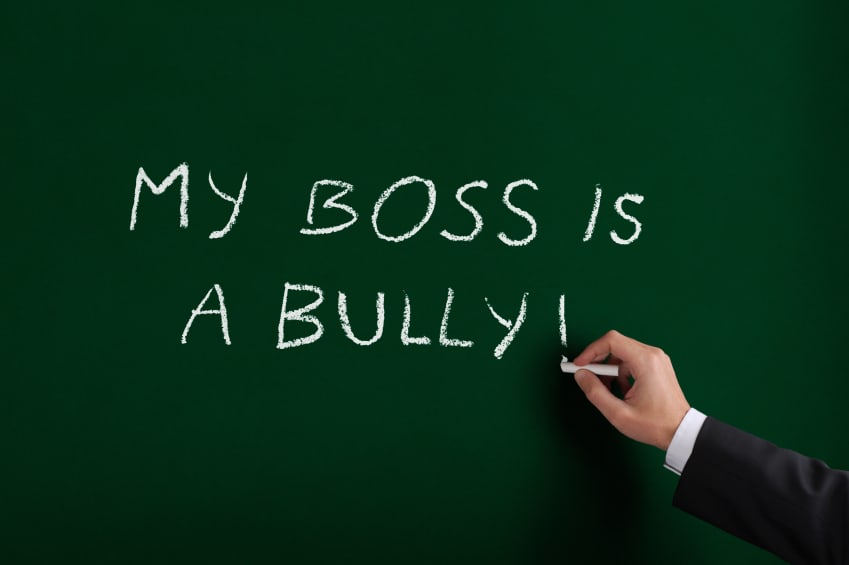 A recent SafetyAtWorkBlog article promoted in LinkedIn has generated many responses, mostly from people who have not read the whole original article, about whether sexual harassment is or is not an occupational health and safety (OHS) matter. Below is a summary of some of those comments. Continue reading “Commenters split on who manages sexual harassment”
A recent SafetyAtWorkBlog article promoted in LinkedIn has generated many responses, mostly from people who have not read the whole original article, about whether sexual harassment is or is not an occupational health and safety (OHS) matter. Below is a summary of some of those comments. Continue reading “Commenters split on who manages sexual harassment”
Tag: human resources
Dangerous personalities making work unsafe – really?
 Australian recruiting firm, Sacs Consulting, has released the findings of a survey entitled “Dangerous Personalities making work unsafe“. Such surveys are predominantly marketing exercises and usually, as in this case, there is a limited amount of data available but the results are often broadly distributed and add to the discussion about workplace safety.
Australian recruiting firm, Sacs Consulting, has released the findings of a survey entitled “Dangerous Personalities making work unsafe“. Such surveys are predominantly marketing exercises and usually, as in this case, there is a limited amount of data available but the results are often broadly distributed and add to the discussion about workplace safety.
The headline itself is a red flag to occupational health and safety (OHS) professionals who are old enough to remember the debate about “blaming the worker” for OHS breaches, injuries and illnesses. Most safety managers and corporate safety programs are applying a “no blame” philosophy to combat the worker focus but the reality is that workers are still being blamed and being dismissed for safety breaches. The Sacs Consulting survey confirms the growing worker focus by looking at the personal rather than the organisational.
The Sacs study found:
“…that some people still ignore OHS rules and act unsafely in the workplace, whereas others value their own safety and that of their colleagues so actively that they try to improve the safety of their workplace. Using personality and values testing, the study was able to predict whether an individual is more or less
likely to be safe at work.” (page 1) Continue reading “Dangerous personalities making work unsafe – really?”
Performance Management may be key to building a safe workplace culture
Occupational safety advice and incident investigations are peppered with the need to have an improved workplace culture. In some ways, workplace culture is another, and broader, way of saying of “system of work”, a concept that has existed in Australian OHS laws for a long time but never received the prominence of clarity it deserved. But how does one develop an improved workplace culture and system of work? Performance Management seems to be one option.
 Performance management is well established in the human resources (HR) discipline but the OHS implications are just being acknowledged in the safety discipline. The concept has been mentioned several times in the public hearings of Australia’s inquiry into workplace bullying as a positive and potential negative.
Performance management is well established in the human resources (HR) discipline but the OHS implications are just being acknowledged in the safety discipline. The concept has been mentioned several times in the public hearings of Australia’s inquiry into workplace bullying as a positive and potential negative.
According to Associate Professor Robin Kramar (now Professor of Human Resource Management at the Australian Catholic University) of in the 2004/2005 edition of CCH’s Australian Master Human Resources Guide, performance management is
“..a way of encouraging behaviour that supports organisational objectives.” (page 19)
This is particularly relevant to the management and removal of psychosocial hazards that safety professionals are increasingly being called on to address or to assist with. Continue reading “Performance Management may be key to building a safe workplace culture”
Another salary survey shows increased demand for OHS professionals
 Australian recruiting company, Hays, has released its annual salary surveyin which it says that there is increasing demand for OHS professionals in Australia however the salary levels seem comparatively low, particularly at the entry-level. The survey says that the introduction of harmonised OHS laws in most Australian States has:
Australian recruiting company, Hays, has released its annual salary surveyin which it says that there is increasing demand for OHS professionals in Australia however the salary levels seem comparatively low, particularly at the entry-level. The survey says that the introduction of harmonised OHS laws in most Australian States has:
“…led to increased accountability and thus demand for high risk safety experts.”
It could be said that many safety experts have been “high risk” but the quote above places safety in a risk context. Safety professionals must be able to understand and deal with business risks in the broader context. In some sectors risk management integrates OHS but in others, where risk management is almost exclusively concerned with insurances and safety is the purview of a Health and Safety Representative, OHS is shunned as a foreign concept or a poorly under threat. Continue reading “Another salary survey shows increased demand for OHS professionals”
Workplace bullying hits the national agenda in Australia
On Saturday morning, May 26 2012, the Australian Prime Minister, Julia Gillard, and her Workplace Relations Minister, Bill Shorten, announced an inquiry into workplace bullying to be undertaken by the House Standing Committee on Education and Employment and to report to Parliament in November 2012.
 This announcement seems to be another that is buried or overtaken by current political events. The Australian Broadcasting Corporation mentioned workplace bullying as a “silent epidemic”. There is a strong risk that the politicians are overstating the workplace bullying case. WorkSafe Victoria receives thousands of enquiries about workplace bullying but only a portion of them fit the workplace bullying definition and only a handful proceed to a prosecution. The government needs to be careful that it is not operating to a perception of workplace bullying instead of the reality, even though the community outrage is genuinely felt.
This announcement seems to be another that is buried or overtaken by current political events. The Australian Broadcasting Corporation mentioned workplace bullying as a “silent epidemic”. There is a strong risk that the politicians are overstating the workplace bullying case. WorkSafe Victoria receives thousands of enquiries about workplace bullying but only a portion of them fit the workplace bullying definition and only a handful proceed to a prosecution. The government needs to be careful that it is not operating to a perception of workplace bullying instead of the reality, even though the community outrage is genuinely felt.
The Age newspaper and AAP, basically printed an edited media release but the most significant statements have not been printed. These are the comments by the Prime Minister, Minister Shorten and the parents of Brodie Panlock, Damian and Rae. Below is a selection or statements from the doorstop transcript:
PM : “I’ve have had the opportunity to have a conversation with Damian and with Rae about their family experience and they will talk about that family experience themselves, but it led to the loss of their daughter Brodie. And they fought hard here in Victoria for Brodie’s law, to have a law that deals with serious bullying at work. Continue reading “Workplace bullying hits the national agenda in Australia”
Business silos extend to, and are supported by, the soft professions
Most managers complain about “silos” even though they often operate comfortably in one. Having an organisational structure that operates without narrow parameters of professional turf is very difficult and sustainable change takes time. Similarly many professions operate in silos and the safety profession is a good example. Rarely does it “play well with others”. A recent workplace relations survey report from the Australian law firm, Madgwicks, illustrates the silo of the professions and its impediment to change.
Most law firms that have occupational health and safety professionals sit the unit with the Workplace Relations portfolio, for good reasons mostly. Workplace Relations, or Industrial Relations in other jurisdictions, deals with the pay and conditions of workers and the negotiation of these issues with employers and business owners. “Pay” is mostly wages and the remuneration received for effort but “conditions’ is more inclusive with OHS a major, but often underplayed, component.
Madgwicks asked two significant questions:
“Currently which workplace relations issues are the most challenging for your business?” and
“Which workplace relations issues do you believe will be the most significant for your business?”
None of the responses (pictured below) to these questions included any occupational health and safety issues. There was no stress. Nothing on workloads or working hours. Nothing on workplace bullying.
Continue reading “Business silos extend to, and are supported by, the soft professions”
Workplace Bullying is a significant challenge even if the reality is smaller than expected
An article in the Weekend Australian newspaper and magazine (not available fully online) provides some statistics that raise serious questions about the level of bullying in workplaces in Australia, with particular focus on Victoria. Of the 2,080 complaints lodged with WorkSafe Victoria in 2010-11
“only eight were deemed serious enough to warrant possible prosecution.”
Yet the OHS regulator received 7,050 inquiries about bullying. There is clearly a problem in Victorian workplaces but it is not always bullying, as defined under OHS law. Something else is happening and it has been happening for some time.
As reported previously in SafetyAtWorkBlog, the issue of workplace relationships is broader than can be handled by one regulator under one law. There are human rights issues, mental health issues, harassment and potential suicides – a range of social issues that should have taken the prevention of “workplace bullying” out of the workplace sometime ago.
The newspaper article, by Richard Guilliatt, draws on several significant cases of proven workplace bullying beyond the more familiar case of Brodie Panlock. Christine Hodder’s suicide in 2005 following bullying in the New South Wales Ambulance Service generated a review of the organisation that found systemic bullying. Sixteen year old Alex Meikle committed suicide in 2008 after many workplace “pranks” that included being set on fire. Continue reading “Workplace Bullying is a significant challenge even if the reality is smaller than expected”
